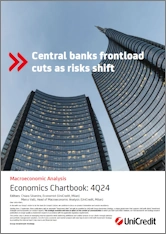Central banks frontload cuts as risks shift
Global: We expect global GDP growth of 3.2% this year and next year, below its long-run average. Recent macro data indicate that economic activity is losing traction, with further weakness in manufacturing and signs of a slowdown in services activity. Meanwhile, disinflation has continued or even accelerated and will likely carry on doing so as labor markets cool and services inflation slows. Global central banks have taken note and have already started to adjust their policies to the shifting balance of risks. We continue to think that the global economy is headed for a soft landing as the removal of monetary-policy restraint in western economies, the absence of major imbalances and policy stimulus in China provide support. There are, however, several prominent risks to the outlook, particularly from US election-related uncertainty, commodity prices and developments in the Middle East, and disruption to trade flows.
US: We forecast the US economy to grow by 2.6% this year and 1.3% in 2025. Real personal spending will likely slow as the labor market continues to soften, household savings buffers are exhausted, consumer confidence is low, and credit conditions are still tight. The election on 5 November remains too close to call. Ms. Harris promises continuity while Mr. Trump has pledged a big rise in tariffs, much lower taxes, and lower immigration. Not everything the candidates promise will turn into policy. We have assumed no big changes to tariffs or fiscal policy, aside from an extension of individual tax cuts. Based on this, we see core PCE inflation slowing to 2% yoy in spring 2025 and the Fed cutting rates by another 50bp by year-end and by 125bp next year. Much higher tariffs and looser fiscal policy would push up inflation and cause the Fed to slow the pace of rate cuts and stop sooner.
Eurozone: GDP is set to rise by 0.7% this year and by 1.1% in 2025. We are reducing the path for sequential growth in 2H24 as the manufacturing sector remains in a downturn while domestic demand continues to struggle. Moderation in price pressure is unfolding quickly and we continue to expect services inflation to drive the final leg of disinflation over the course of 2025. The materialization of downside risks to both its growth and inflation forecasts raises the pressure on the ECB to accelerate the return towards a more neutral stance. We now expect the next 100bp of easing to be delivered swiftly, with 25bp cuts at consecutive meetings, probably already starting on 17 October. We expect the deposit rate to reach a terminal level of 2% in September 2025.
CEE: We forecast GDP growth of 2.7% this year and 2.9% in 2025 in EU-CEE1, and above 3% in both years in the Western Balkans and Turkey. Domestic demand will remain the strongest growth driver, helped by real wage growth, fiscal transfers and falling interest rates. We expect net exports to contribute to growth in 2025, when capex might accelerate. We forecast cautious rate cuts this year, with more to come in 2025.
UK: We see GDP growth of 0.9% this year and next year. Despite a strong rebound in 1H24, underlying growth remains subdued and fiscal policy looks set to become a headwind when the new government details how it will fill a “black hole” in the Autumn Budget on 30 October. The BoE has said it favors a gradual approach to cutting rates, but we still expect cuts of 25bp per meeting through end-3Q25 as services inflation and wage growth slow quickly next year amid a deteriorating labor market.
China: We confirm our forecast for GDP growth of 4.8% in 2024 but have revised our 2025 forecast upward, to 4.5% from 4.3%, as China’s central government now seems committed to using both fiscal- and monetary-policy levers to ameliorate a weakening economic outlook and rising deflationary risks. Most of the policy measures that have been announced so far are designed to stimulate demand, but weak consumer spending is partly due to fears of households about structural economic problems. Further policy action is likely to be announced soon, but an all-in fiscal stimulus remains unlikely.
.
UniCredit Economic Chartbook (PDF)
Source: UniCredit Group Investment Strategy - UniCredit Economics Chartbook, 1 October 2024, Executive summary
1 EU-CEE refers to CEE countries that are members of the EU: Bulgaria, Croatia, Czechia, Hungary, Poland, Romania, Slovakia and Slovenia






